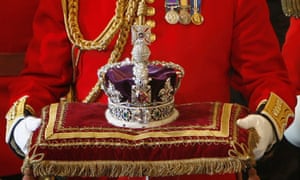Size, as we know, is not everything. You might only be the 90th largest, but you can still emerge with a sizable reputation. This is one of several lessons to be learned from the story of the Koh-i-Noor diamond, way down the list in terms of size but, as this new book’s subtitle suggests, looming large in the imagination. It is probably also the world’s most dangerous diamond, described here as being “like a living, dangerous bird of prey” because so many have lost their lives over it.
The origins of the Koh-i-Noor, the “mountain of light”, are unknown, beyond the reach even of this book’s two accomplished authors, but it seems safe to assume that it emerged out of alluvial deposit somewhere in India. It may have been known in antiquity and it may have been referred to in many a romantic tale, but its first verifiable appearance isn’t until the 18th century, where it decorated the Mughal emperor’s Peacock Throne in Delhi and where it stimulated envy and greed in the emperor’s rivals. Over the following 100 years, it brought torment and tragedy to a range of people in Delhi, Kabul and Lahore.
The history of the diamond is quickly told – it’s a rock, after all, so there’s only so much story it can have. But the history of the many who have coveted the diamond is long and involved, full of wonder and awe, treachery and bloodshed. It is told here by William Dalrymple, known for entertaining travel writing and sweeping histories, particularly of the British in India and, most recent, in Afghanistan, and by Anita Anand, whose previous book told the story of the granddaughter of the last Indian maharaja to own the diamond.
Dalrymple tells the earlier history, when the diamond was established as an emblem of power and sovereignty. He does this with his habitual panache, sweeping along the trail from the Mughal court in Delhi to Persia, where the diamond was taken by Nader Shah in 1739, to Afghanistan and then in 1813 to Lahore, where it was worn by the great Sikh maharaja Ranjit Singh. There are enough grand durbars with the diamond strapped to princely biceps and terrible moments of eyes being pricked by needles and brains being fried with molten metal to keep the pages turning.
Anand’s task is more complicated, for she covers the history of the stone and its owners since the cremation of Ranjit Singh in June 1839. The key moment occurred 10 years later and involved Ranjit’s 10-year-old heir, Maharaja Duleep Singh. British-led forces under Governor-General Lord Dalhousie had just taken control of the maharaja’s state of Punjab in an act of perfidy that will be familiar to anyone who has read our imperial story: three years earlier, the British had assured the prince’s advisers that they would stay until he was 16, old enough to rule by himself. Now, before his 11th birthday, he was handed a document to sign to “resign for himself, his heirs, and successors all right, title and claim to the sovereignty of the Punjab, or to any sovereign power whatever”. Item three of the five-clause document required him to “surrender” the Koh‑i‑Noor to Queen Victoria.
The story of the diamond’s arrival in London, its display at the Great Exhibition of 1851, the recutting of the stone by Prince Albert and the Duke of Wellington to give it brilliance, the tragic life of the boy-prince who converted to Christianity and came to England – all has been told before. Why tell it now? Dalrymple explains that when the British acquired the diamond, Lord Dalhousie commissioned Theo Metcalfe to write the diamond’s story and the clerk duly complied, constructing an “enjoyably lively but entirely unsubstantiated” narrative “based on Delhi bazaar gossip”. Dalrymple and Anand have gone some way to rectifying the situation. But much remains unverified and open to interpretation. And much remains mired in inaccuracy, as was apparent last year when the Indian solicitor general, discussing a claim on the diamond in the Indian supreme court, stated that the diamond had been given to Queen Victoria by Maharaja Ranjit Singh, not by his son. Dalrymple’s much anticipated book on the East India Company may well provide more background to this story.
Anand closes the book by looking to the future and wondering whether the Koh-i-Noor might be returned to Iran, Afghanistan, Pakistan or India, all of whom have claims on it. She also imagines it on the head of a future Queen Camilla. But perhaps it will stay in the Tower of London, where our current queen has left it, declining to place it on her head. And why should she? After all, it is only the 90th largest diamond in the world. Each of the Queen’s two Cullinan diamonds are significantly larger and they come without the Koh-i-Noor’s baggage.
Soruce: theguardian


No comments:
Post a Comment